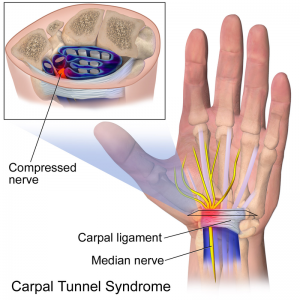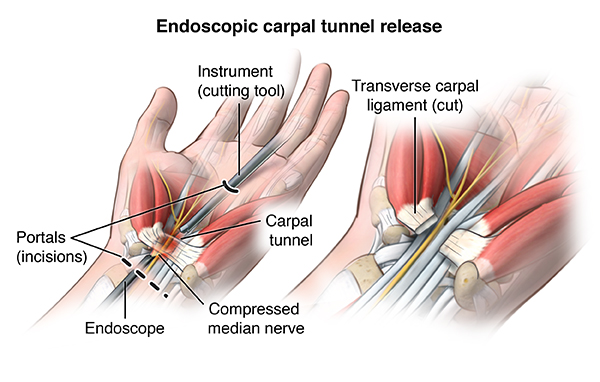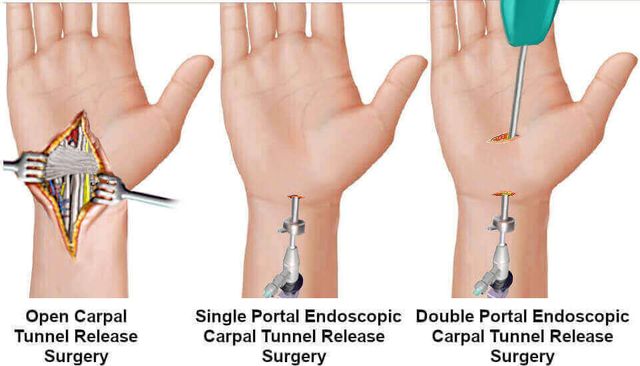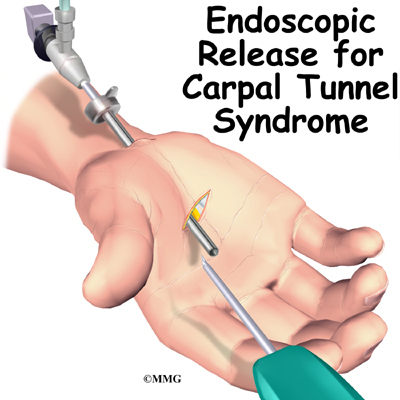Carpal Tunnel Surgery Which Method Is Most Commonly Used
Surgery is indicated in almost all patients with moderate to severe CTS. The other method is endoscopic carpal tunnel release in which a thin flexible tube that contains a camera is put into the wrist through a tiny incision cut.

Carpal Tunnel Syndrome Physiopedia
Carpal tunnel release is one of the most common surgical procedures in the United States.

. The metrics used to assess outcomes in each studies were collected compared and described. Severe or persistent cases may be treated surgically by performing a carpal tunnel release CTR during which the transverse carpal ligament TCL is transected to relieve pressure on the median nerve. The traditional treatment for carpal tunnel syndrome often performed in Middle Eastern countries is a liberating surgery in which a 5 cm incision is made in the wrist.
It can lead to pain numbness and sometimes disability of the hands. The surgeon cuts a carpal ligament either in open or endoscopic surgery. Ad A home treatment Kit that works for 97 of people - Over 450000 people healed naturally.
The most commonly used carpal tunnel injection method involves a large suction-type instrument being placed into the carpal tunnel. An absolute indication for CT release CTR is muscular atrophy 105. When possible our surgeons use minimally invasive surgery that includes a small incision cut and miniature instruments to release the carpal tunnel.
About 260000 of them decide to treat it with surgery. A doctor may recommend surgery to a patient who has not benefited from conservative treatments. The remainder 74 million use non-surgical remedies.
In this outpatient procedure which means the patient can go home after the surgery is completed the surgeon makes two-inch incisions on the afflicted wrists and. Doctors diagnose over 8 million people a year with carpal tunnel syndrome. After surgery you may need to wear a wrist splint for about a week.
Carpal tunnel release is a surgery to treat carpal tunnel syndrome. There are 2 types of carpal tunnel release surgery. Carpal tunnel syndrome remains a primarily clinical diagnosis although ultrasound has supplemented electrodiagnostic testing as a confirmatory tool.
Carpal tunnel release CTR surgery continues to evolve. Carpal tunnel syndrome is a common disorder caused by compression of the median nerve in the wrist. This ligament holds part of the wrist bones together.
Two different types of surgical approaches are in use for the treatment of CTS. There are two types of surgical procedures used to cut and release the transverse carpal. Carpal Tunnel Release is one of the most common surgical procedures in the United States and is usually done as an outpatient procedure.
It is then held in place by a ring that is tightened around the wrist. Surgery is usually done under local or regional anesthesia involving some sedation and does not require an overnight hospital stay. There are two main types of carpal tunnel surgery.
Carpal tunnel surgery involves relieving pressure on the median nerve by cutting part of the carpal ligament. Open carpal tunnel release surgery. Surgery is often used as the last resort but it is important to understand what to expect after carpal tunnel injection vs.
This is done by cutting releasing the ligament that covers the carpal tunnel at the base of the palm. Carpal and cubital tunnel syndromes are the two most commonly diagnosed upper extremity mononeuropathies Several epidemiologic studies have linked disease incidence of carpal tunnel syndrome to female gender and increased BMI as well as to patient age One study reported an incidence of approximately 376100000 person years with a higher. Nearly all the studies used a patient-reported outcome measure PROM to assess outcomes 94.
Generally surgery involves severing a ligament around the wrist to reduce pressure on the median nerve. Then the transverse ligament is cut to enlarge the tunnel space. Both are outpatient procedures.
Surgery consists of division of transverse carpal ligament. Carpal tunnel syndrome is also corrected through surgery the most common of which is the carpal tunnel release which is normally conducted under local anesthesia to relieve the amount of pressure on the median nerve by severing the tissue surrounding the wrist. While most patients choose non-surgical treatments they must be used diligently and properly in order to permanently eliminate symptoms.
This reduces the pressure on the median nerve by increasing the space in the carpal tunnel. Open release and endoscopic carpal tunnel release. This instantaneously takes the pressure off.
Most carpal tunnel surgeries are performed using the open technique which involves a 1-2 inch incision in the palm. The most common PROMs used were the Boston Carpal Tunnel Questionnaire 60 and the Visual Analog Scale for pain 51. There are two basic types or procedures used for carpal tunnel release surgery.
Electromyogram and NCS can be costly can require multiple visits may induce anxiety and. There are 2 types of carpal tunnel release surgery. Endoscopic carpal tunnel release surgery can be performed under regional or general anesthesia and is sometimes associated with less pain.
Carpal tunnel release surgery one of the most common outpatient surgeries in the US can cure the condition. Endoscopic carpal tunnel release surgery consisting of single portal or double portal methods Both types involve cutting the transverse carpal ligament in the hand. The other method is endoscopic carpal tunnel release in which a thin flexible tube that contains a camera is put into the wrist through a tiny incision.
The traditional method is the open release in which the surgeon cuts open the wrist to do the surgery. Magnetic resonance imaging of the carpal tunnel has also showed some promise as an alternative method for the examination of the median nerve. Open release surgery is the most common procedure in treating this condition.
There are two major types of surgery used for treating carpal tunnel syndrome. Traditional CTR procedures have included open and endoscopic CTR. Currently electrodiagnostic testing which comprises electromyogram EMG and nerve conduction studies NCS is the most commonly used method for confirming the clinical diagnosis of carpal tunnel syndrome CTS.
The traditional method is the open release in which the surgeon cuts open the wrist to do the surgery. This method is used more commonly than open surgery and gives you less pain and scarring and a quicker recovery. The goal of surgery is to increase the size of the tunnel in order to decrease the pressure on the nerves and tendons that pass through the space.



No comments for "Carpal Tunnel Surgery Which Method Is Most Commonly Used"
Post a Comment